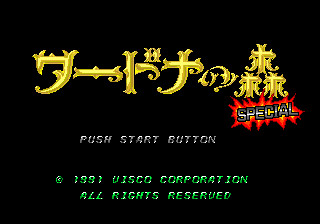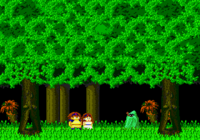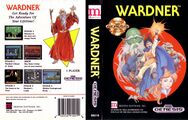Wardner
From Sega Retro
| |||||||||||||||
| Wardner | |||||||||||||||
|---|---|---|---|---|---|---|---|---|---|---|---|---|---|---|---|
| System(s): Sega Mega Drive | |||||||||||||||
| Publisher: Visco (Japan), Mentrix Software (US) | |||||||||||||||
| Developer: Dragnet | |||||||||||||||
| Original system(s): Arcade boards | |||||||||||||||
| Developer(s) of original games: Toaplan | |||||||||||||||
| Sound driver: Dragnet/Kazuo Okabayashi | |||||||||||||||
| Genre: Action[1] | |||||||||||||||
| Number of players: 1 | |||||||||||||||
| Official in-game languages: | |||||||||||||||
| |||||||||||||||
|
Wardner is a platform game developed by Dragnet and released for the Sega Mega Drive in 1991. In Japan, it was known as Wardner no Mori Special (ワードナの森SPECIAL) and published by Visco. In North America, it was published by Mentrix Software.
It is based on a 1987 arcade game called Wardner no Mori in Japan and Pyros in North America, which was developed by Toaplan and published by Taito.
Columbus Circle (in a deal with Tatsujin) announced an aftermarket re-release of the game in Japan for September 2024, dropping the Special from the title and naming it as Wardner no Mori instead.[4]
Contents
Story
A boy named Dover and a girl named Mia are wandering about when they get lost in the forest of the sinister warlock Wardner. Suddenly, a green spectre comes and kidnaps Mia, leaving Dover to find her.
Gameplay
The game is a side-scrolling platformer played as Dover, who traverses a fantasy land to rescue Mia. The early stages are linear, populated with obstacles and enemies, requiring the player to traverse the stage by running, jumping, climbing, shooting or dodging enemies, while later stages are more maze-like and exploratory, making the player take different routes to reach the end. Dover walks with ![]() and
and ![]() and crouches with
and crouches with ![]() . He jumps with
. He jumps with ![]() or
or ![]() . He can squeeze through tight spots by jumping while crouching. He automatically grabs vines when he passes in front of them and climbs them with
. He can squeeze through tight spots by jumping while crouching. He automatically grabs vines when he passes in front of them and climbs them with ![]() and
and ![]() .
.
Dover attacks enemies by shooting fireballs at them with ![]() . Defeated enemies drop Crystals, which power up Dover's attack, or Money Bags, which can be used to buy items in the shop. Dover initially shoots one fireball at a time in a downward trajectory; he must wait until the fireball dissipates by hitting the ground or an enemy before he can shoot another. By collecting 16 Small Crystals (or a single Large Crystal), Dover gains the ability to shoot another fireball, up to a maximum of 8. Additionally, after a stage is completed, the player enters a shop and can spend the money collected from enemies to buy magic items that change the pattern of Dover's attacks. Only one such item can be held at a time, and it is kept until it is replaced or until the end of the game.
. Defeated enemies drop Crystals, which power up Dover's attack, or Money Bags, which can be used to buy items in the shop. Dover initially shoots one fireball at a time in a downward trajectory; he must wait until the fireball dissipates by hitting the ground or an enemy before he can shoot another. By collecting 16 Small Crystals (or a single Large Crystal), Dover gains the ability to shoot another fireball, up to a maximum of 8. Additionally, after a stage is completed, the player enters a shop and can spend the money collected from enemies to buy magic items that change the pattern of Dover's attacks. Only one such item can be held at a time, and it is kept until it is replaced or until the end of the game.
Ordinarily, Dover dies after taking a single hit from an enemy or hazard. He can find (or buy in the shop) the Magical Cape item, which allows him to withstand one more hit. If he has a cape, purchasing the Needle and Thread item from the shop allows him to repair it in order to take one additional hit. If he dies, he restarts the stage at a predetermined checkpoint. Some hazards, such as spikes and lava, instantly kill Dover regardless of what items he possesses. There is also a timer, and Dover loses a life if he does not complete the stage before time runs out (unless he has the Magical Clock item, which grants him another 30 seconds after time runs out). Some stages contain NPCs, and the timer resets when talking to them. The player gains extra lives at certain points thresholds. Stages contain hidden spots that reward the player with bonus points for moving over them.
Items
| Small Crystal | |
|---|---|
| Collect 16 to increase the number of fireballs that Dover can shoot at a time, up to a maximum of 8. Sometimes dropped by defeated enemies. | |
| Large Crystal | |
| Increases the number of fireballs that Dover can shoot at a time, up to a maximum of 8. | |
| Money Bag | |
| Rewards Dover with $50. Sometimes dropped by defeated enemies. | |
| Treasure Chest | |
| Rewards Dover with $200. | |
| Magical Cape | |
| Allows Dover to absorb one hit without dying. His sprite changes to show him wearing a cape when he has this item. | |
| Magical Clock | |
| Gives the player an extra 30 seconds once the timer runs out. A Clock icon appears next to the timer when Dover has this item. | |
| Ocarina | |
| This item is only dropped by the first giant bee enemy in the third stage. If Dover possesses this item while standing in the middle of the fire lake, a phoenix appears and flies him to the end of the stage. | |
| High Jump Shoes | |
| This item is only dropped by the second giant bee enemy in the third stage. It turns Dover's next jump into a super high jump, but only lasts for one jump. | |
| Faerie Statue | |
| Causes a faerie to follow Dover. Faeries are invulnerable and destroy enemies that they touch (as well as enemy projectiles). Faeries last from stage to stage, until Dover loses a life. Up to two faeries can follow Dover at a time. | |
| 1-Up | |
| Awards the player with an extra life. |
Shop
The player enters a shop after completing each of the first four stages.
| Magic of Stars | |
|---|---|
| Upgrades Dover's fireballs to fly in a zigzag motion. Costs $1,500. | |
| Magic of the Moon | |
| Upgrades Dover's fireballs to loop around in circles. Costs $2,000. | |
| Magic of the Sun | |
| Upgrades Dover's fireballs to shoot out into a rapid beam. This is the only attack that shoots all of his fireballs out at once. Costs $3,000. | |
| Magical Cape | |
| Allows Dover to absorb one hit without dying. His sprite changes to show him wearing a cape when he has this item. Costs $300. | |
| Needle and Thread | |
| Allows Dover to take an additional hit without dying when wearing the cape. A Needle and Thread icon appears in the top-right corner of the screen when Dover has this item. Costs $200. | |
| Magical Clock | |
| Gives the player an extra 30 seconds once the timer runs out. A Clock icon appears next to the timer when Dover has this item. Costs $300. |
Stages
| Woods | |
|---|---|
| Trap House | |
| Lava Woods | |
| Castle, Lower Section | |
| Castle, Upper Section | |
| Dungeon | |
Versions
The game has been remixed for the Mega Drive port: Stage 2 got a new boss (was a reused stage 1 boss). Stage 3 got the Arcade version's Stage 4 boss (original stage 3 boss was also a reused boss). Stage 4 has been split up into stages 4 and 5, with new bosses added. These resulting stages also contain a few extra sections. The final series of rooms leading to Wardner has also been changed significantly, with the home port having the double amount of rooms and differing obstacles in them. The final boss had a safe spot just in front of his knee, allowing to defeat him with no effort. This has been fixed by changing his attack pattern. Various other changes exist such as different hidden bonuses.
The graphical conversion left much to be desired. Parts of it, such as missing background details, world map and shop entrance graphics, can be explained by the small ROM size. Other changes however, appear to have been avoidable. Multiple stages have big parts of the color palette unused. All enemies aside from the floating skulls draw their colors from this limited pool. Color positions were swapped for unknown reasons, so that objects in the background appear brighter than in the foreground.
Localised names
| Language | Localised Name | English Translation |
|---|---|---|
| English (US) | Wardner | Wardner |
| Japanese | ワードナの森SPECIAL | Wardner no Mori Special |
Production credits
- Producer: Tetsuo Akiyama
- Original Works: Toa Plan
- Director:" Yasuhisa Itoi
- Assistant Director: Don Gabacho, Ann Hirakawa
- Programing: Masaharu Ohno, Takanori Kohno, Hirosi Ogura
- Character Design: Toa Plan, Kyoko Tachibana
- Music: Toa Plan, Kazuo Okabayashi
- Music Arrange: Kazuo Okabayashi
- Sound Effect: Kazuo Okabayashi, Masaharu Ohno
- Special Thanks: K.Kamio
- Presented by Mentrix Software, Inc.
Magazine articles
- Main article: Wardner/Magazine articles.
Promotional material
also published in:Expand
Physical scans
| ExpandSega Retro Average |
|---|
| 62 | |
|---|---|
| Based on 28 reviews | |
Technical information
- Main article: Wardner/Technical information.
References
NEC Retro has more information related to Wardner no Mori
|
- ↑ Jump up to: 1.0 1.1 https://sega.jp/history/hard/megadrive/software_l.html (Wayback Machine: 2020-07-02 23:21)
- ↑ Beep! MegaDrive, "April 1991" (JP; 1991-03-08), page 12
- ↑ Jump up to: 3.0 3.1 GamePro, "May 1991" (US; 1991-xx-xx), page 37
- ↑ https://www.columbuscircle.co.jp/products/?id=1718265711-028526&p=1&ca=49 (Wayback Machine: 2024-06-22 21:44)
- ↑ File:Wardner MD credits.pdf
- ↑ GamePro, "16-bit Video Gaming: February 1992" (US; 1992-xx-xx), page 13
- ↑ 1700 igr dlya Sega, "" (RU; 2001-xx-xx), page 332
- ↑ ACE, "August 1991" (UK; 1991-07-08), page 64
- ↑ ACE, "December 1991" (UK; 1991-11-08), page 127
- ↑ Ação Games, "Julho 1991" (BR; 1991-07-xx), page 43
- ↑ Aktueller Software Markt, "August/September 1991" (DE; 1991-07-26), page 118
- ↑ Beep! MegaDrive, "April 1991" (JP; 1991-03-08), page 30
- ↑ Console XS, "June/July 1992" (UK; 1992-04-23), page 136
- ↑ Mean Machines: The Essential Sega Guide, "" (UK; 1993-11-18), page 114
- ↑ Famitsu, "" (JP; 1991-0x-xx), page 1
- ↑ GamePro, "May 1991" (US; 1991-xx-xx), page 36
- ↑ Games-X, "4th-10th July 1991" (UK; 1991-07-04), page 40
- ↑ Hippon Super, "April 1991" (JP; 1991-03-04), page 42
- ↑ Joystick, "Juin 1991" (FR; 1991-0x-xx), page 132
- ↑ Sega Mega Drive Advanced Gaming, "November 1992" (UK; 1992-xx-xx), page 79
- ↑ Jump up to: 21.0 21.1 Sega Mega Drive Advanced Gaming, "January 1993" (UK; 199x-xx-xx), page 95
- ↑ Mega Drive Fan, "July 1991" (JP; 1991-06-08), page 85
- ↑ MegaTech, "Xmas 1991" (UK; 1991-12-06), page 81
- ↑ Mean Machines, "July 1991" (UK; 1991-06-29), page 70
- ↑ Mean Machines Sega, "October 1992" (UK; 1992-09-xx), page 142
- ↑ Power Play, "8/91" (DE; 1991-07-1x), page 118
- ↑ Sega Power, "October 1991" (UK; 1991-09-05), page 55
- ↑ Sega Power, "December 1991" (UK; 1991-10-30), page 37
- ↑ Sega Pro, "April 1992" (UK; 1992-03-19), page 31
- ↑ Jump up to: 30.0 30.1 Sega Pro, "April 1993" (UK; 1993-03-11), page 68
- ↑ Sega Saturn Magazine, "September 1995" (JP; 1995-08-08), page 87
- ↑ Tilt, "Décembre 1991" (FR; 1991-1x-xx), page 42
| CollapseWardner | |
|---|---|
|
Main page | Comparisons | Maps | Development | Magazine articles | Reception | Region coding | Technical information | |






























